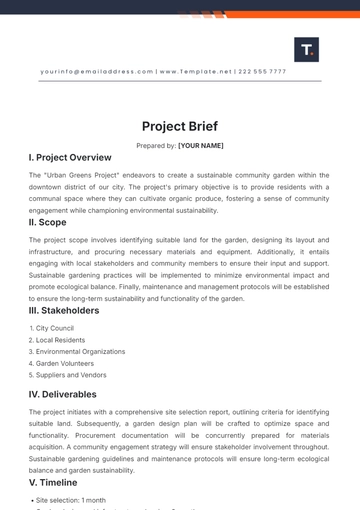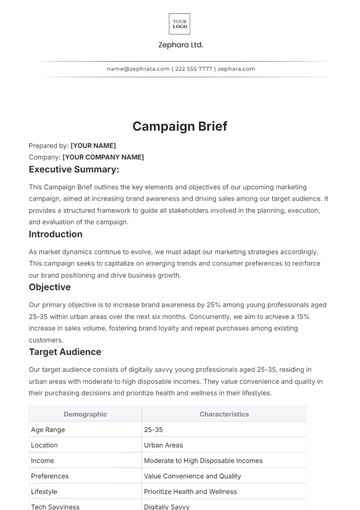Free Communications Brief

Prepared by: [YOUR NAME]
Company: [YOUR COMPANY NAME]
To: Communication Team Members
I hope this communication finds you in good spirits. In light of the dynamic nature of our organizational landscape and the potential challenges that may arise, our communication strategies must remain robust and highly adaptable. This comprehensive Communications Brief aims to provide you with a detailed guide on Crisis Communication, ensuring our collective preparedness to navigate unforeseen circumstances with professionalism and efficiency.
Introduction
The primary objective of this brief is to equip our communication team with an in-depth understanding of crisis communication principles and practical guidelines, facilitating effective management and resolution of crises that may impact our organization.
Target Audience:
This brief is specifically crafted for members of the communication team, encompassing both leadership and support roles. It is essential reading for those directly involved in crisis management and individuals who contribute to communication strategy development and implementation.
Key Message:
The key message of this brief is to underscore the critical importance of proactive crisis communication preparedness. By adhering to the outlined guidelines, the communication team will play a pivotal role in maintaining the organization's reputation and trustworthiness during challenging times.
Definition of Crisis Communication
Crisis Communication Defined:
Crisis communication, as pertains to our operations, involves the strategic management of information during and after a crisis to minimize reputational damage and ensure timely, accurate, and transparent communication with all stakeholders.
Key Components of Crisis Communication
Preparation:
Conducting a comprehensive risk assessment to identify potential crises
Establishing a Crisis Communication Team with clearly defined roles and responsibilities
Developing detailed crisis communication plans and protocols
Response:
Creating a coordinated and dynamic crisis response strategy
Establishing clear communication channels and decision-making frameworks Designating a centralized crisis communication command center
Recovery:
Conducting post-crisis evaluations and lessons-learned sessions
Implementing reputation management strategies
Establishing mechanisms for rebuilding trust with stakeholders
Communication Protocols
Internal Communication:
Guidelines for communicating with employees during crises
Coordinated internal messaging to maintain a cohesive narrative across departments
External Communication:
Protocols for engaging with media and external stakeholders
Crafting and disseminating official statements through various communication channels
Media Relations
Media Training:
Ongoing training sessions for designated spokespersons
Conducting realistic crisis communication scenarios for media interactions
Media Monitoring:
Implementing real-time media monitoring tools
Establishing rapid response mechanisms to counteract misinformation
Digital Communication
Social Media Management:
Monitoring and managing social media channels during crises
Providing guidelines for appropriate online responses and engagement
Website and Online Platforms:
Maintaining an updated crisis communication section on our official website
Establishing protocols for updates on relevant online platforms during crises
Testing and Exercises
Simulation Exercises:
Regularly conducting realistic crisis communication drills
Analyzing simulation outcomes to identify areas for improvement and refinement
Reporting Procedures
Incident Reporting:
Establishing clear protocols for reporting potential crises
Designating a chain of command for incident reporting and response coordination
Conclusion:
In conclusion, a proactive and well-coordinated Crisis Communication strategy is vital for safeguarding the trust and confidence of our stakeholders during challenging times. By thoroughly familiarizing ourselves with the contents of this brief and diligently implementing the outlined guidelines, we can collectively contribute to the resilience and reputation of our organization.
- 100% Customizable, free editor
- Access 1 Million+ Templates, photo’s & graphics
- Download or share as a template
- Click and replace photos, graphics, text, backgrounds
- Resize, crop, AI write & more
- Access advanced editor
Elevate your communication game with the Communications Brief Template from Template.net. Crafted for efficiency, this editable and customizable template streamlines your message creation process. Unlock limitless possibilities with its user-friendly interface, effortlessly tailoring your briefs to perfection. Editable in our Ai Editor Tool, it's the ultimate solution for polished and professional communication.





























